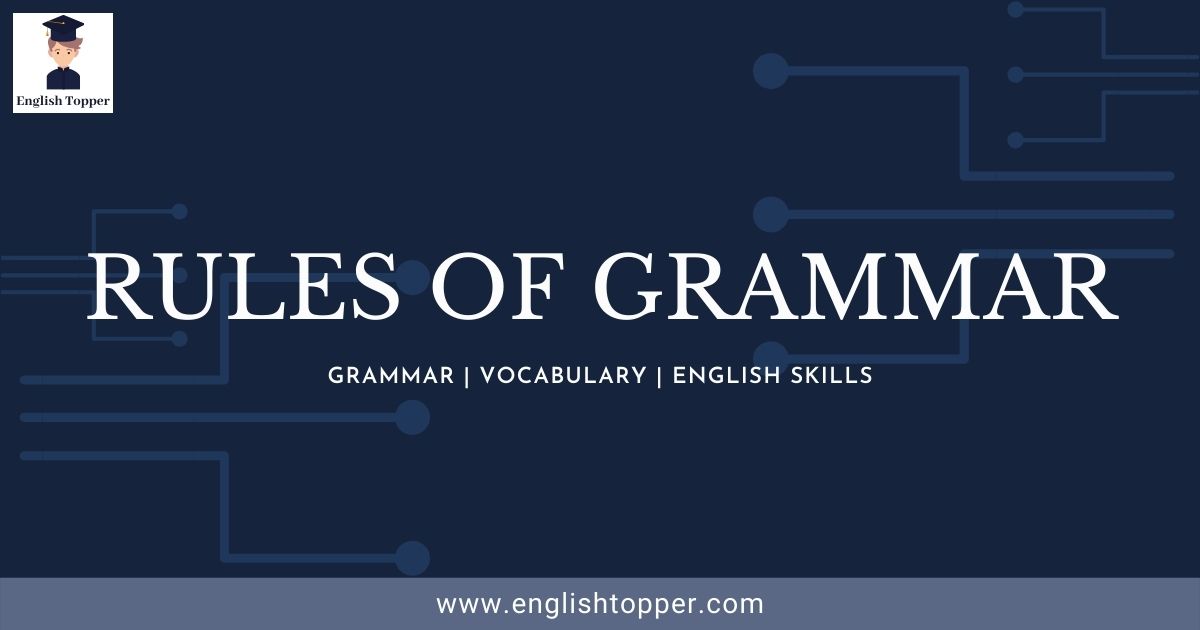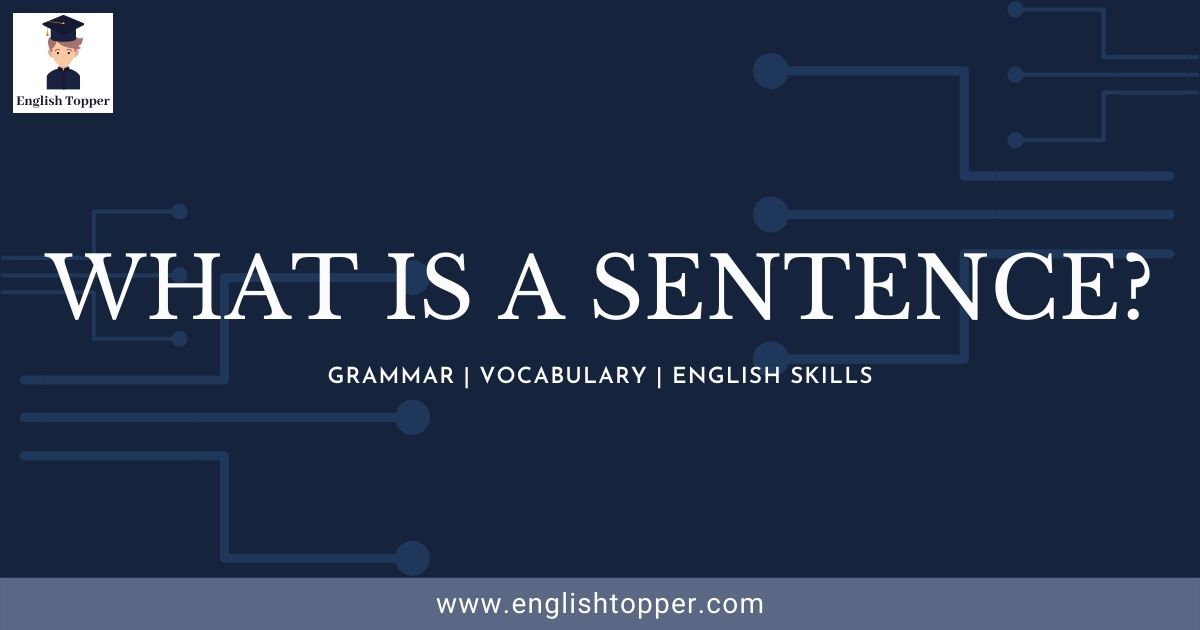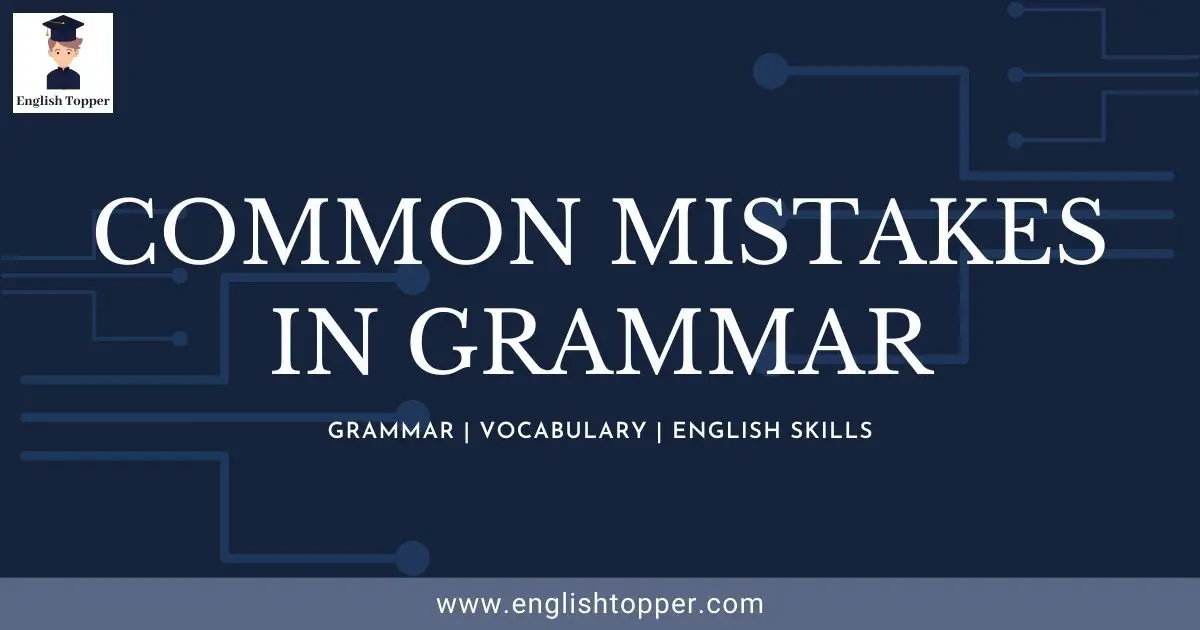Table of Contents
Introduction
When you want to write something (like an article, letter, CV, etc) in the English Language, you will make sure that it is meaningful and error-free, but it’s obvious that you make a lot of mistakes in Grammar.
Grammar errors like spelling, prepositions, sentence structure & formation, etc are common while writing.
So as we know that every language has its own grammar, we are going to explain these 12 rules of Grammar to avoid those errors and write well.
Also Read: What is Grammar? | (Grammar definition, rules & examples) | Best Guide 2021
Rules of Grammar
Here are some sets of rules that you need to follow in order to avoid mistakes in English grammar.
Rule 1: Every sentence should start with a Capital letter in the first word.
In the English Language, when you are starting a sentence, then make sure that you capitalize the first letter of the first word. Also, remember that you need to capitalize even when you start a new paragraph.
Example Statements:
- Incorrect: my best friend’s name is Rohan. he is a good boy. (X)
- Correct: My best friend’s name is Rohan. He is a good boy. (_/)
- Incorrect: i live in Mumbai. it is a wonderful place. (X)
- Correct: I live in Mumbai. It is a wonderful place. (_/)
Rule 2: Every sentence should either end with a full stop (or) a question mark (or) an exclamation mark.
If you want to end a sentence, then make sure that you need to use a full stop (.), a question mark (?) or an exclamation mark (!) based on the type of the sentence.
The above, any of the three mentioned should be used depending on the situation of the sentence. For example, let us consider a few examples with its usages (purpose).
1) Full Stop/Period (.):
Here, the full stop is used when a sentence completes a proper message (meaning). The symbol used for the full stop is (.).
Example Statements:
- John loves to play football. He dreams to become a football player.
- I am living in London for 2 years.
- I purchased a new car. It is very expensive.
2) Question Mark (?):
Question marks are used only for questioning (or) interrogating sentences. It is used at the end of the sentence, to make it questionable. The symbol used for questioning is “?”.
Example Statements:
- Which college are you studying from?
- Do you know who I am?
- Where do you live?
- Are you still playing these old games?
- Do you know how to swim?
3) Exclamation Mark (!):
An Exclamation Mark is used when you are expressing your feelings or emotions. So, when you are expressing it in a sentence, you need to remember that exclamation should be done at the end.
The symbol which is used for the sentence is “!”.
Example Statements:
- She actually won the lottery!
- Wow, such a wonderful place it is!
- You are late again!
- You did a great job!
Rule 3: Every sentence should have SVO (Subject – Verb – Object).
The basic rule of grammar in the English Language is that you must include Subject and Verb. The object is optional depending on the usage.
This order is only applicable for positive sentences, not for sentences with negatives or question marks (?) or exclamation marks (!) because they may have different orders.
The Subject usually plays a major role in the entire sentence. It helps you to give an idea of who is performing an action, who is talking to whom, etc.
The verb is usually the action which is performed by the Subject, and the object is usually on which the action is performed.
Sometimes, a few sentences don’t mention the subject. Actually, it has a subject, and it is understood even if it is not shown. For example, consider the word “Stop!” – which means that you must stop (here “you” is hidden).
Example Statements:
- Mary loves to play with cats. (S – Mary, V – play, O – cats)
- Michael teaches French. (S – Michael, V – teaches, O – French)
- We are planning to visit Singapore. (S – We, V – planning, O – Singapore)
- I am happy. (S – I, V – am, O – happy)
- Come here! (It means – “You come here!”) (Here, the subject is hidden)
Rule 4: The Subject and Verb forms are interrelated in the sentence.
If you are using a singular Subject, then you need to use a singular Verb for the whole sentence and if you want to use a Plural subject, then you must use a plural verb.
If you are using he/she/it as a Subject, then use its corresponding verb and when using we/they/I/you, then use its verb.
Example Statements:
- Harry wants to buy a new bike.
- We are going to a restaurant this weekend.
- We don’t like to go to the library.
- They are watching a football match on TV.
- She likes to stay in London.
- They want to have coffee this evening.
Rule 5: Use Either – or (or) Neither – nor depending on the Sentence while using singular nouns.
In English sentences, Either – or and Neither – nor is used when two singular nouns are connected. These two are different in usage. Also, remember that the singular verb is used for singular nouns.
Either – or:
Either – or is used when any one of the two cases is true. This means that either this must be true or that.
Example Statements:
- Raju and Srikanth must be either friends or enemies.
- I want either Tea or Coffee.
- I think either Team A or Team B will win this match.
Neither – or:
Neither – or is used when two of the (subject) cases are false. This means that both are false.
Example Statements:
- Neither I nor you broke the vase.
- Neither John nor Mike are late today.
- Neither I nor you must win this game.
Rule 6: Proper Nouns should be capitalized anywhere in the sentences (including at the beginning) when used.
It is important to capitalize on the words which are Proper Nouns. This can be at the beginning, middle and end of the sentences (in short, anywhere in the sentence).
Example Statements:
- I love to drink coffee at Starbucks.
- I will eat only high-protein foods.
- I have final exams from tomorrow.
- Mount Everest is the highest mountain located in Nepal.
Rule 7: Common Nouns should be capitalized only at the beginning of the sentences.
When common nouns are used, then you need to capitalize them only at the beginning of the sentences.
Example Statements:
- I have beautiful flowers in my garden.
- I love to read books in the library.
- My school is located near the railway station.
- Tina went to a supermarket to buy groceries.
Rule 8: The words its – it’s, and you’re – your are not the same.
Some words in the English Language look like they are the same, but they have different meanings. Now let us take some examples to understand the concept well.
Here, the main difference between its and it’s is,
- its: It is a Possessive determiner and used to say that it belongs (holds or refers to) something.
- it’s: Here “it’s” is the short form of “it is” and is used to mention things.
Example Statements (for its):
- This fish is too big for its aquarium.
- This bread has passed its expiration date.
- The dog has hurt its tail.
Example Statements (for it’s):
- It’s taking so much time to prepare this presentation.
- It’s always raining here.
- It’s good to know the current politics of your area.
- It’s been a wonderful day!
Rule 9: Use Indefinite Articles for Countable Nouns and Definite with specific Countable & all Uncountable Nouns.
The Indefinite Articles (a/an) are used mostly for Countable nouns. Definite Articles (the) are used for a few Countable nouns and mostly for Uncountable nouns.
Example Statements:
- I saw an eagle which is flying very high in the sky.
- The principal asked a student about his performance.
- Arun is a brilliant student in the class.
- An apple a day keeps the doctor away.
- Hari is a good boy. He likes to help others.
- I want to buy an iPhone this month.
Rule 10: Use the article “a” for Consonant sounds and “an” for vowel sounds.
Use the article “a” for the words which sound Consonant at the very beginning. For example, consider the below table.
Consonant Sounded Words | With Article (a) |
bat | a bat |
cat | a cat |
dog | a dog |
fish | a fish |
gun | a gun |
hat | a hat |
jug | a jug |
kite | a kite |
lemon | a lemon |
mat | a mat |
Use the article “an” for the words which sound Vowel at the very beginning. For example, consider the below table.
Vowel Sounded Words | With Article (an) |
apple | an apple |
eagle | an eagle |
elephant | an elephant |
orange | an orange |
umbrella | an umbrella |
igloo | an igloo |
apron | an apron |
Note: When you’re using “a” or “an” then make to focus on pronunciation rather than the word’s spelling. Few words look like consonants, but it actually pronounces like vowels. For example, “an hour”.
If you want to read more about Articles, then click on the button below or read from the suggestion link.
Also Read: What are Articles in English Grammar? | (with easy examples)
Rule 11: Use Apostrophe to show Possessions.
Possession is something which is usually owned by a person, place, thing, etc. It has two forms, which are Singular and Plural.
For Singular use (-‘s) and for plural use (-s’).
Example Statements:
- Boy’s car (Singular)
- Boys’ car (Plural)
- Raju’s car got damaged last night.
- Ravi’s friend came to Europe to visit Ravi.
Also Read: What is a Possessive Noun? (with examples) | Best Guide 2021
Rule 12: Active voice is more preferred than Passive voice in the English Language.
Most of them recommend writing Active voice rather than Passive voice while writing articles, letters, etc.
In simple terms, an Active voice is a sentence in which the subject performs an action (verb). Whereas in Passive Voice, the Verb (action) is displayed first and then the Subject.
Example Statements:
- Passive Voice: Football was played by Raju.
- Active Voice: Raju plays football.
Click the below button to learn about Active and Passive Voice in detail.
Quiz Time! (Test Your Knowledge Here)
#1. Which article is used for hour?
#2. Correct and rewrite the sentence, "he is a lazy person and doesn't complete his work on time"
Answer: He is a lazy person and doesn’t complete his work on time.
#3. I usually order pizza from Dominos. Identify the Proper Noun (P) and Common Noun (C).
Answer: Proper Noun is Dominos and Common Noun is Pizza.
#4. Correct the Possession for the given sentence, "Todays temperature is very high."
Answer: Today’s temperature is very high.
#5. Rewrite the given sentence, "today, Raju has purchased a new car he is very excited about it"
Answer: Today, Raju has purchased a new car. He is very excited about it.
#6. Which word is wrong in the sentence, "Tina want to buy a new house."
Answer: Tina wants to buy a new house. Here “wants” should be used because the subject (Tina) is singular.
#7. He can have _______ a pizza _____ a burger.
Answer: He can have either a pizza or a burger.
#8. "Raju car is not working properly." - Rewrite the sentence with Possession.
Answer: Raju’s car is not working properly.
#9. Correct the given sentence, "do you know where I live"
Answer: Do you know where I live?
#10. Passive voice is considered more than Active voice. Is it true?
Answer: It is false.
Results
|
Getting your Trinity Audio player ready...
|
Hurray….. You have passed this test! 🙂
Congratulations on completing the quiz. We are happy that you have understood this topic very well.
If you want to try again, you can start this quiz by refreshing the page.
Otherwise, you can visit the next topic 🙂
|
Getting your Trinity Audio player ready...
|
Oh, sorry about that. You didn’t pass this test! 🙁
Please read the topic carefully and try again.
Summary: (12 Rules of Grammar)

If you want to write better in the English Language, then you need to focus on these 12 Rules of Grammar, which I have mentioned above.
The 12 Rules of Grammar are:
- Every sentence should start with a Capital letter in the first word.
- Every sentence should either end with a full stop (or) a question mark (or) an exclamation mark.
- Every sentence should have SVO (Subject – Verb – Object).
- The Subject and Verb forms are interrelated in the sentence.
- Use Either – or (or) Neither – nor, depending on the Sentence, while using singular nouns.
- Proper Nouns should be capitalized anywhere in the sentences (including at the beginning) when used.
- Common Nouns should be capitalized only at the beginning of the sentences.
- The words its – it“a”’s, and you’re – your not the same.
- Use Indefinite Articles for Countable Nouns and Definite with specific Countable & all Uncountable Nouns.
- Use the article “a” for Consonant sounds and “an” for vowel sounds.
- Use apostrophes to show Possessions.
- Active voice is more preferred than Passive voice in the English Language.
Also Read: What is Grammar? | (Grammar definition, rules & examples) | Best Guide 2021
If you are interested to learn more, then you can refer to Wikipedia here.
I hope that you understood the topic “12 Rules of Grammar”. If you have any doubts regarding this topic, then comment down below, and we will respond to your questions as soon as possible. Thank You.









I would like to improve my English.
Good 🙂
This is great work. I’m impressed. You make everything sound so simple and easy to understand. I think you are a great teacher.
Thanks for your appreciation, Susan Scott. I am glad that this article helped you a lot. Don’t forget to share it with your families and friends. 🙂
My last answer of the Quiz (Proper Noun: Dominos
Common Noun:pizza)
But still I got it wrong
May I know why?
Hi Reshma, thank you for bringing notice to me about the wrong option. Your answer is correct. I have corrected it in the quiz 🙂
I love this platform. Is there a community where we can interact with good English, to help us sharpen our understanding.
Thanks for your appreciation! I am planning to start a new forum to build a community, and stay connected. I will notify everyone once when it is ready. 🙂
I like it.
I am glad to know 🙂
i comfortable with practice
Good, keep practising 🙂
Am really excited about this assessment. Wish to practice and improve on my grammar.
Glad to hear. All the best 🙂
Thank you for sharing
You’re welcome!
I really enjoyed this field. I really want to improve my English.
I am glad that you’re enjoying while learning. Good luck!
I have added to my knowledge through this article.I look forward to learning more new ideas from you.
Sure, and don’t forget to share this blog with your friends and families.
I am a volunteer ESL teacher and have no previous experience teaching reading or language arts. The textbooks our program uses have individual chunks of grammar, but not together in one place. This is a good overview of the beginning basics. Thank you, I will use it with my learner and share it with other tutors.
Thank you Rachel for sharing it with others. I hope this blog helps you to learn English in the best way possible.